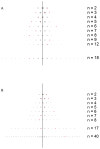Testing for an unusual distribution of rare variants
- PMID: 21408211
- PMCID: PMC3048375
- DOI: 10.1371/journal.pgen.1001322
Testing for an unusual distribution of rare variants
Abstract
Technological advances make it possible to use high-throughput sequencing as a primary discovery tool of medical genetics, specifically for assaying rare variation. Still this approach faces the analytic challenge that the influence of very rare variants can only be evaluated effectively as a group. A further complication is that any given rare variant could have no effect, could increase risk, or could be protective. We propose here the C-alpha test statistic as a novel approach for testing for the presence of this mixture of effects across a set of rare variants. Unlike existing burden tests, C-alpha, by testing the variance rather than the mean, maintains consistent power when the target set contains both risk and protective variants. Through simulations and analysis of case/control data, we demonstrate good power relative to existing methods that assess the burden of rare variants in individuals.
Conflict of interest statement
The authors have declared that no competing interests exist.
Figures



References
-
- Cohen J, Pertsemlidis A, Kotowski IK, Graham R, Garcia CK, et al. Low ldl cholesterol in individuals of african descent resulting from frequent nonsense mutations in pcsk9. Nat Genet. 2005;37(2):161–165. - PubMed
-
- Cohen JC, Boerwinkle E, Mosley TH, Hobbs HH. Sequence variations in PCSK9, low ldl, and protection against coronary heart disease. N Engl J Med. 2006;354(12):1264–1272. - PubMed
-
- Kathiresan S, Melander O, Anevski D, Guiducci C, Burtt NP, et al. Polymorphisms associated with cholesterol and risk of cardiovascular events. N Engl J Med. 2008;358(12):1240–9, PMID 18354102. - PubMed
-
- Cohen JC, Kiss RS, Pertsemlidis A, Marcel YL, McPherson R, et al. Multiple rare alleles contribute to low plasma levels of hdl cholesterol. Science. 2005;305(5685):869–872. - PubMed
-
- Morgenthaler S, Thilly WG. A strategy to discover genes that carry multi-allelic or mono-allelic risk for common diseases: a cohort allelic sums test (cast). Mutat Res. 2007;615(1-2):28–56. - PubMed
Publication types
MeSH terms
Grants and funding
- R01 MH089208/MH/NIMH NIH HHS/United States
- R37 MH057881/MH/NIMH NIH HHS/United States
- EY11309/EY/NEI NIH HHS/United States
- MH089025/MH/NIMH NIH HHS/United States
- R01 DK072041/DK/NIDDK NIH HHS/United States
- R01 MH057881/MH/NIMH NIH HHS/United States
- R01 EY011309/EY/NEI NIH HHS/United States
- MH057881/MH/NIMH NIH HHS/United States
- DK072041/DK/NIDDK NIH HHS/United States
- NS059727/NS/NINDS NIH HHS/United States
- MH089208/MH/NIMH NIH HHS/United States
- R01 HL087676/HL/NHLBI NIH HHS/United States
- R01 NS059727/NS/NINDS NIH HHS/United States
- R01 MH089025/MH/NIMH NIH HHS/United States
- U10 EY011309/EY/NEI NIH HHS/United States
- HL087676/HL/NHLBI NIH HHS/United States
LinkOut - more resources
Full Text Sources

